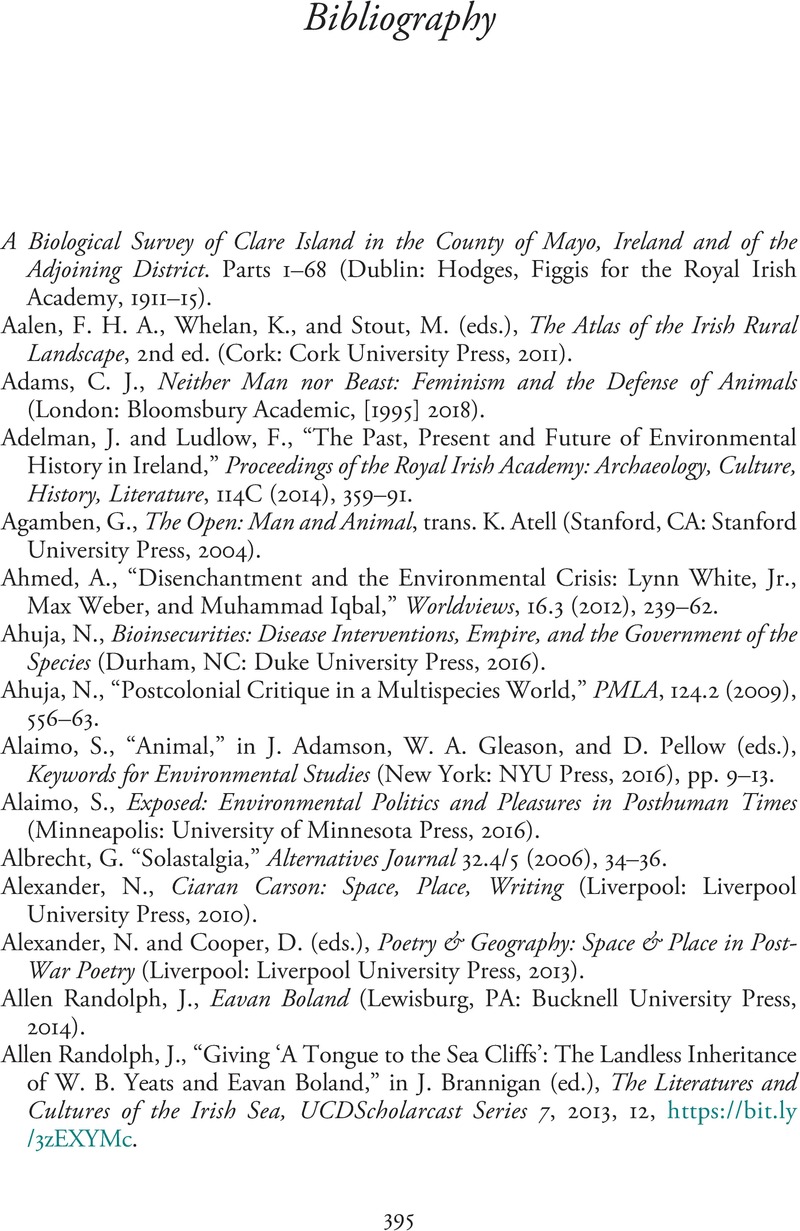Book contents
- A History of Irish Literature and the Environment
- A History of Irish Literature and the Environment
- Copyright page
- Contents
- Figures
- Tables
- Contributors
- Introduction Culture, Climate, Capital, and Contagion
- Chapter 1 Landscape and Literature in Medieval Ireland
- Chapter 2 The Irish Annals and Climate, Fifth–Seventeenth Centuries CE
- Chapter 3 The Environmental Vocabulary of Irish Folklore
- Chapter 4 Narratives of Arboreal Landscapes
- Chapter 5 Famine and Ecology, 1750–1900
- Chapter 6 Political Ecology in Nationalist Literature, 1880–1922
- Chapter 7 Solastalgic Modernism and the West in Irish Literature, 1900–1950
- Chapter 8 The Ecology of the Irish Big House, 1900–1950
- Chapter 9 Refuge and Domestic Space in Northern Irish Poetry, ca. 1940–Present
- Chapter 10 Irish Travellers, the Environment, and Literature
- Chapter 11 The Oceanic Imaginaries of Modern Irish Writing
- Chapter 12 Landscape in Irish-Language Literature: Poetry and Prose, 1900–2000
- Chapter 13 Poetry and Place
- Chapter 14 Animals and Climate Crisis in Irish Poetry
- Chapter 15 Animals and Animality in Irish Fiction
- Chapter 16 The Political Ecology of Food and Hunger, 1950–Present
- Chapter 17 Built Environments and Lived Ecologies in Contemporary Irish Poetry, 1998–Present
- Chapter 18 Transnationalism and Environment in Contemporary Irish Literature
- Chapter 19 Energy Futures in Contemporary Irish Fiction
- Bibliography
- Index
- References
Bibliography
Published online by Cambridge University Press: 14 July 2022
- A History of Irish Literature and the Environment
- A History of Irish Literature and the Environment
- Copyright page
- Contents
- Figures
- Tables
- Contributors
- Introduction Culture, Climate, Capital, and Contagion
- Chapter 1 Landscape and Literature in Medieval Ireland
- Chapter 2 The Irish Annals and Climate, Fifth–Seventeenth Centuries CE
- Chapter 3 The Environmental Vocabulary of Irish Folklore
- Chapter 4 Narratives of Arboreal Landscapes
- Chapter 5 Famine and Ecology, 1750–1900
- Chapter 6 Political Ecology in Nationalist Literature, 1880–1922
- Chapter 7 Solastalgic Modernism and the West in Irish Literature, 1900–1950
- Chapter 8 The Ecology of the Irish Big House, 1900–1950
- Chapter 9 Refuge and Domestic Space in Northern Irish Poetry, ca. 1940–Present
- Chapter 10 Irish Travellers, the Environment, and Literature
- Chapter 11 The Oceanic Imaginaries of Modern Irish Writing
- Chapter 12 Landscape in Irish-Language Literature: Poetry and Prose, 1900–2000
- Chapter 13 Poetry and Place
- Chapter 14 Animals and Climate Crisis in Irish Poetry
- Chapter 15 Animals and Animality in Irish Fiction
- Chapter 16 The Political Ecology of Food and Hunger, 1950–Present
- Chapter 17 Built Environments and Lived Ecologies in Contemporary Irish Poetry, 1998–Present
- Chapter 18 Transnationalism and Environment in Contemporary Irish Literature
- Chapter 19 Energy Futures in Contemporary Irish Fiction
- Bibliography
- Index
- References
Summary

- Type
- Chapter
- Information
- A History of Irish Literature and the Environment , pp. 395 - 432Publisher: Cambridge University PressPrint publication year: 2022

